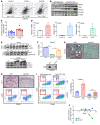A tumor-intrinsic PD-L1/NLRP3 inflammasome signaling pathway drives resistance to anti-PD-1 immunotherapy
- PMID: 32017708
- PMCID: PMC7190922
- DOI: 10.1172/JCI133055
A tumor-intrinsic PD-L1/NLRP3 inflammasome signaling pathway drives resistance to anti-PD-1 immunotherapy
Abstract
An in-depth understanding of immune escape mechanisms in cancer is likely to lead to innovative advances in immunotherapeutic strategies. However, much remains unknown regarding these mechanisms and how they impact immunotherapy resistance. Using several preclinical tumor models as well as clinical specimens, we identified a mechanism whereby CD8+ T cell activation in response to programmed cell death 1 (PD-1) blockade induced a programmed death ligand 1/NOD-, LRR-, and pyrin domain-containing protein 3 (PD-L1/NLRP3) inflammasome signaling cascade that ultimately led to the recruitment of granulocytic myeloid-derived suppressor cells (PMN-MDSCs) into tumor tissues, thereby dampening the resulting antitumor immune response. The genetic and pharmacologic inhibition of NLRP3 suppressed PMN-MDSC tumor infiltration and significantly augmented the efficacy of anti-PD-1 antibody immunotherapy. This pathway therefore represents a tumor-intrinsic mechanism of adaptive resistance to anti-PD-1 checkpoint inhibitor immunotherapy and is a promising target for future translational research.
Keywords: Cancer immunotherapy; Chemokines; Immunology; Innate immunity; Oncology.
Conflict of interest statement
Figures







Similar articles
-
Tumor-intrinsic NLRP3-HSP70-TLR4 axis drives premetastatic niche development and hyperprogression during anti-PD-1 immunotherapy.Sci Transl Med. 2022 Nov 23;14(672):eabq7019. doi: 10.1126/scitranslmed.abq7019. Epub 2022 Nov 23. Sci Transl Med. 2022. PMID: 36417489 Free PMC article.
-
Targeting tumor-derived NLRP3 reduces melanoma progression by limiting MDSCs expansion.Proc Natl Acad Sci U S A. 2021 Mar 9;118(10):e2000915118. doi: 10.1073/pnas.2000915118. Proc Natl Acad Sci U S A. 2021. PMID: 33649199 Free PMC article.
-
SOX2 promotes resistance of melanoma with PD-L1 high expression to T-cell-mediated cytotoxicity that can be reversed by SAHA.J Immunother Cancer. 2020 Nov;8(2):e001037. doi: 10.1136/jitc-2020-001037. J Immunother Cancer. 2020. PMID: 33158915 Free PMC article.
-
Pyroptosis, a new bridge to tumor immunity.Cancer Sci. 2021 Oct;112(10):3979-3994. doi: 10.1111/cas.15059. Epub 2021 Aug 10. Cancer Sci. 2021. PMID: 34252266 Free PMC article. Review.
-
Modulation of PD-1/PD-L1 axis in myeloid-derived suppressor cells by anti-cancer treatments.Cell Immunol. 2021 Apr;362:104301. doi: 10.1016/j.cellimm.2021.104301. Epub 2021 Feb 4. Cell Immunol. 2021. PMID: 33588246 Review.
Cited by
-
Myeloid-derived suppressor cells in cancer and cancer therapy.Nat Rev Clin Oncol. 2024 Feb;21(2):147-164. doi: 10.1038/s41571-023-00846-y. Epub 2024 Jan 8. Nat Rev Clin Oncol. 2024. PMID: 38191922 Review.
-
Signal pathways of melanoma and targeted therapy.Signal Transduct Target Ther. 2021 Dec 20;6(1):424. doi: 10.1038/s41392-021-00827-6. Signal Transduct Target Ther. 2021. PMID: 34924562 Free PMC article. Review.
-
Crosstalk between metabolism and cell death in tumorigenesis.Mol Cancer. 2024 Apr 4;23(1):71. doi: 10.1186/s12943-024-01977-1. Mol Cancer. 2024. PMID: 38575922 Free PMC article. Review.
-
IL-1R1 Blockade Boosts CD40 Agonist Immune Responses but Fails to Improve Efficacy or Reduce Hepatotoxicity in Pancreatic Cancer.bioRxiv [Preprint]. 2025 Mar 17:2025.02.23.639774. doi: 10.1101/2025.02.23.639774. bioRxiv. 2025. PMID: 40060615 Free PMC article. Preprint.
-
Pharmacological Wnt ligand inhibition overcomes key tumor-mediated resistance pathways to anti-PD-1 immunotherapy.Cell Rep. 2021 May 4;35(5):109071. doi: 10.1016/j.celrep.2021.109071. Cell Rep. 2021. PMID: 33951424 Free PMC article.
References
Publication types
MeSH terms
Substances
Grants and funding
LinkOut - more resources
Full Text Sources
Other Literature Sources
Medical
Research Materials

